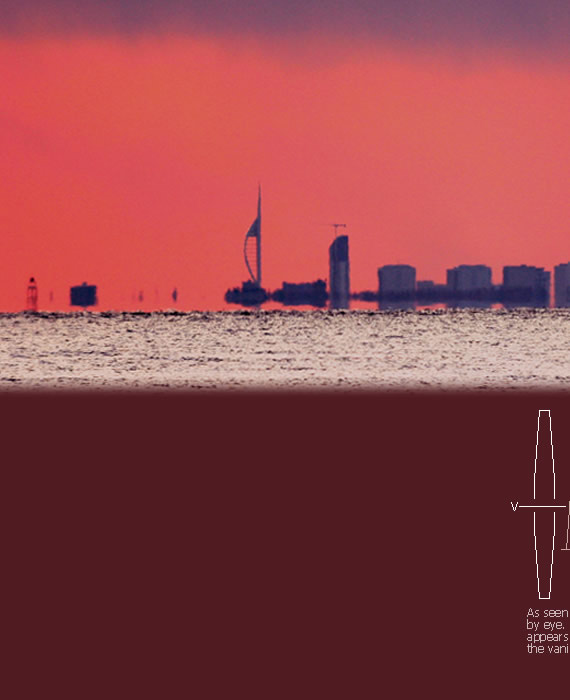Mirage from Selsey
beach, southern England imaged by Mark Parrish April 6, '08 shortly
after sunset, the Portsmouth skyline 23km away is seen apparently
mirrored in the sea. ©Mark
Parrish,
shown with permission
The mirage, called an 'inferior mirage' because
the image is below the real object, is produced by a layer of abnormally
warm air heated by the sea and beneath cooler layers. Light passing at
low angles across the layers is refracted so that rays coming from the
tops of the building appear to be coming upwards from the horizon. Our
brain interprets that as a reflection from water.
There is more. The horizon is missing
and the base of buildings and low lying land cannot be seen either
below or above the line joining the 'real' view and the mirage.
This is a 'vanishing-line' effect.
The ray diagram at right tries to show what is happening but like
all mirage ray diagrams the vertical scale has to be grossly exaggerated.
All possible rays between the eye and a distant tower
are shown. Two rays from the tower top (A) reach the eye. The upper
one is slightly curved downwards towards the warmer air. The lower
ray is sharply curved and appears to the eye to come from a tower
reflected in water. Rays from lower down (B) do the same. Position
(C) is different. Only one ray reaches the eye. Rays from lower down
the tower cannot reach the eye at all - that part of the tower is
invisible!
The level (C) is the level of the mirage "vanishing-line".
The 'real' view and inverted mirage view join at the vanishing
line and the eye can see no details of the scene that are below it. the
more distant the object, the higher is the vanishing line
When the mirage is above the object it is called 'superior'. An extreme
example, a Fata Morgana, is here. Mirages
of the sun can produce a green flash.
|



